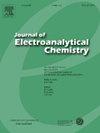用于高效碱性水电解的双功能镍-铁电极的基底和电位驱动表面形貌
IF 4.1
3区 化学
Q1 CHEMISTRY, ANALYTICAL
引用次数: 0
摘要
利用时变法合成了镍铁(Ni-Fe)合金电极。系统研究了基底类型(铜、不锈钢和镍)和沉积电位对结构、形态和电催化特性的影响。X 射线衍射 (XRD) 分析显示形成了面心立方 (FCC) 镍铁合金。在较高电位(-1.45 V)下电沉积会形成清晰的纳米片,而在较低电位(-1.00 V)下电沉积则会形成聚集的镍-铁颗粒。在电流密度为 10 mA/cm2 时,氢进化反应(HER)的过电位为 -168 mV,氧进化反应(OER)的过电位为 236 mV。基于纳米片的 Ni-Fe 合金的电催化活性的增强归因于其较大的催化表面积、多孔形态和较高的铁浓度。Ni-Fe 合金电极具有双功能电催化行为,因此非常适合 HER 和 OER 过程。本文章由计算机程序翻译,如有差异,请以英文原文为准。
Substrate and potential-driven surface morphology of bifunctional Ni-Fe electrode for efficient alkaline water electrolysis
Nickel-iron (Ni-Fe) alloy electrodes are synthesized using chronoamperometry. The influence of substrate type (copper, stainless steel, and nickel) and deposition potential on the structural, morphological, and electrocatalytic characteristics are systematically investigated. X-ray diffraction (XRD) analysis revealed the formation of a face-centered cubic (FCC) Ni-Fe alloy. Electrodeposition at higher potential (−1.45 V) forms well-defined nanoflakes, whereas electrodeposition at lower potential (−1.00 V) results aggregated Ni-Fe particles. The Ni-Fe alloy electrodes having well-defined nanoflakes demonstrated superior electrocatalytic performance, exhibiting a overpotential of −168 mV vs. RHE for the hydrogen evolution reaction (HER) and 236 mV vs. RHE for the oxygen evolution reaction (OER), at current density of 10 mA/cm2. The enhanced electrocatalytic activity of the nanoflakes based Ni-Fe alloy is attributed due to their larger catalytic surface area, porous morphology and higher Fe concentration. The Ni-Fe alloy electrodes displayed bifunctional electrocatalytic behavior, making them highly suitable for both HER and OER processes.
求助全文
通过发布文献求助,成功后即可免费获取论文全文。
去求助
来源期刊
CiteScore
7.80
自引率
6.70%
发文量
912
审稿时长
2.4 months
期刊介绍:
The Journal of Electroanalytical Chemistry is the foremost international journal devoted to the interdisciplinary subject of electrochemistry in all its aspects, theoretical as well as applied.
Electrochemistry is a wide ranging area that is in a state of continuous evolution. Rather than compiling a long list of topics covered by the Journal, the editors would like to draw particular attention to the key issues of novelty, topicality and quality. Papers should present new and interesting electrochemical science in a way that is accessible to the reader. The presentation and discussion should be at a level that is consistent with the international status of the Journal. Reports describing the application of well-established techniques to problems that are essentially technical will not be accepted. Similarly, papers that report observations but fail to provide adequate interpretation will be rejected by the Editors. Papers dealing with technical electrochemistry should be submitted to other specialist journals unless the authors can show that their work provides substantially new insights into electrochemical processes.

 求助内容:
求助内容: 应助结果提醒方式:
应助结果提醒方式:


